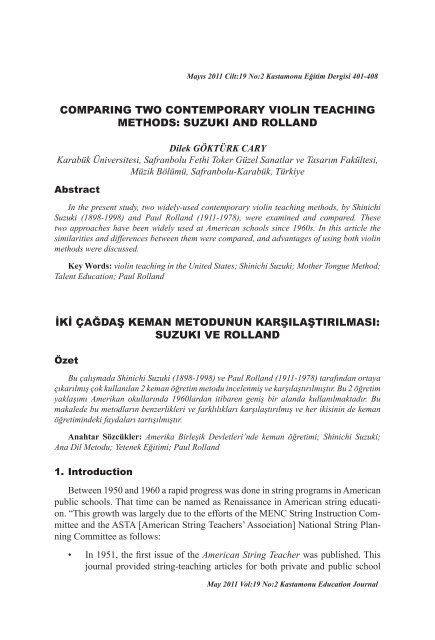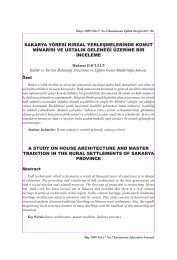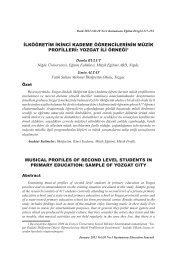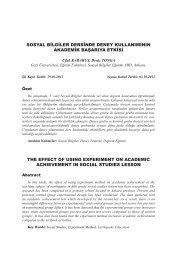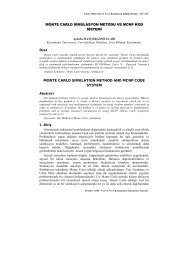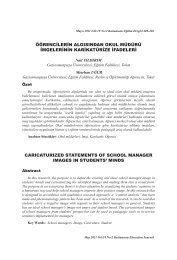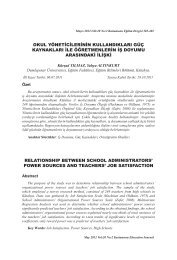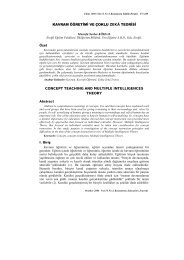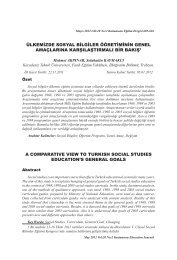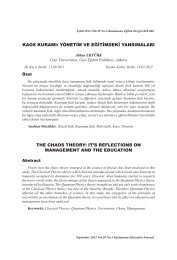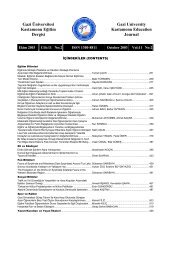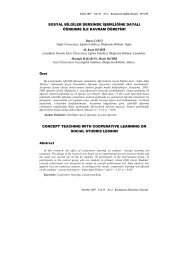comparing two contemporary violin teaching methods
comparing two contemporary violin teaching methods
comparing two contemporary violin teaching methods
Create successful ePaper yourself
Turn your PDF publications into a flip-book with our unique Google optimized e-Paper software.
Comparing Two Contemporary Violin Teaching Methods: Suzuki And ... 403ter the World War II. According to Suzuki, talent is not innate but can be developedby individual. He stated in his Nurtured by Love that “Talent is no accident of birth…Man is grown with natural ability. A newborn child adjusts to his environment in orderto live, and various abilities are acquired in the process.” (6) Suzuki also believedthat talent was only a helpful element to develop the ability quicker than others.Suzuki’s basic idea regarding to his pedagogy was the Mother Tongue method. He observedthat all Japanese children could speak their mother tongue, so he thought thatchildren could learn how to play <strong>violin</strong> in the same way. He observed the practicabilityof this method as follows:• The environmental conditions and their influence on the new-born baby as itaccustoms itself to the sounds of the ‘mother tongue.’• Teaching the child by constant repetition to utter its first sound. Usually‘mama mama mama’ and so on.• Everyday attitude of the parents after the baby starts to talk.• Natural progress through daily practice.• The skillfulness with which the parents build up enthusiasm in the child, andthe happiness of the child finds in acquiring its new-found ability. (7).In addition to Rolland’s String Research Project conducted and recorded at theUniversity of Illinois in Urbana-Champaign in Illinois (and supported by the Elementaryand Secondary Education Act (ESEA) in 1965), another project was also sponsoredby ASTA in 1960s to bring the Suzuki Method to the attention of American stringteachers. Through this project, Shinichi Suzuki came to the United States to performfor the ASTA conferences first in 1964 and then in 1967. The <strong>two</strong> most important principalsby Suzuki from his Mother Tongue approach are as follows:• All children are encouraged to strive for their potential. Given the right environment,any child can learn to do anything, and in particular, to play the <strong>violin</strong>.This musical environment includes supportive and actively involved parents,listening to good music from an early age (including the early <strong>violin</strong> pieces),and good instrumental training.• Children can learn to do anything given enough repetitions in an encouragingenvironment. As a result, practice is based upon the number of repetitions ratherthan the quantity of time. (8).In sum, the Suzuki approach in string <strong>teaching</strong> is based on listening. Accordingto this principle, listening is the basic activity that should be done daily by students.Another principle is learning to read music by rote. “Contrary to the more traditionalapproach of learning a musical instrument, Suzuki’s Mother-Tongue method does notuse printed music with beginners. Instead, students listen to recordings of the litera-May 2011 Vol:19 No:2 Kastamonu Education Journal
404Dilek GÖKTÜRK CARY...ture they play.” (9)Another main idea of Suzuki’s string <strong>teaching</strong> pedagogy is parental involvement.Suzuki believed in parents being at the center of his plan, and according to him mothersare strongly encouraged participating lessons. “Not only do they attend each privatelesson, ands monthly ensemble class, but they also actually learn to play the instrumentthemselves, taking lessons during the first few months when the child is tolisten to the recordings. When the child begins to take lessons, the mothers take notes,study the manuals, and practice daily with the child at home, basing their help onconstant encouragement and patient repetition.” (10). Indeed, repetition is the mainfactor of achievement in Suzuki philosophy in string <strong>teaching</strong>. “Repetition is crucialfor success in the Suzuki approach. After learning a composition, students must continueto review it, for Suzuki maintains that in ideal practice working for perfection onthe previous piece is the most important point for cultivating abilities.” (11). Motivationconcept is also very important in Suzuki approach. Encouraging students throughconstructive support and stimulation, for instance “ ‘Very good. Can you do better?’ isthe basic Suzuki formula” (12).3. Paul Rolland (1911-1978) and Rolland Method“Get them started right and aim them in the right direction and they will reach thetop . . . It is a fallacy to believe that the careful <strong>teaching</strong> of fundamentals will slowdown the pupil . . . Most elements of string playing can be introduced, in embryonicform of course, during the first year of instruction, and refined thereafter . . . One wouldbe quite surprised at what pupils can be started on during the first and second years. . . Music educators should strive to develop players who not only play in tunewith a good sound but who also feel comfortable and happy in so doing, and who usewell coordinated movements without excessive tension as they play . . . It is of paramountimportance to develop a well balanced stance, balanced right and left arms,and a balanced hold . . . Good balance is the key to efficient movements . . . A smallchild can be taught to play with a beautiful tone and sonority by the use of good balanceof the body and by avoiding static tensions in his movements . . . Stressed is freedomof movement; trying to inculcate the pupil with a feeling of kinesthesia, a feelingof lightness, both with the bow and the instrument . . . naturalness, naturalness,natural- ness . . .” (13)Paul Rolland (1911-1978) was born in Hungary and trained in Europe. After comingto the United States in the 1930s, he became a professor at the University of Illinois.He began to develop his string pedagogy in the 1950s. “Rolland based his pedagogyon the similarity of natural everyday movements to the motions required forstring playing. The word ‘motion’ defines the operative and often overlooked modeof thought.” (14). In his project, “Young beginning string players were recruited fromthe Urbana Public Schools, in the Illinois town where Rolland resided. Rolland andMayıs 2011 Cilt:19 No:2 Kastamonu Eğitim Dergisi
Comparing Two Contemporary Violin Teaching Methods: Suzuki And ... 405his research associates taught approximately one hundred students for a <strong>two</strong>-year trial,using the principles that Rolland had developed over the course of his <strong>teaching</strong> career.Out of the project came a book called The Teaching of Action in String Playing(1974). This book was designed and developed to help classroom string teachers teachmovements conducive to good string playing in a group setting. Rolland produceda set of illustrative films to accompany the text of the book.” (15). His vibrato andshifting techniques are still popular today. According to Rolland “Teaching, and thereforelearning, occurs in <strong>two</strong> channels: Developmental and Remedial. New skills,new knowledge should be introduced, and impressions already gained must be deepened,and constantly refined. Of the <strong>two</strong> channels, the first one is always more popularwith the student, and the teacher should guard against being carried away by progresswhich is too fast and without real substance and quality.” (16).4. ConclusionIn conclusion, the similarities and differences were discussed between the <strong>two</strong>string <strong>methods</strong>.Similarities between Suzuki and Rolland <strong>methods</strong>Similarities between Rolland and Suzuki <strong>methods</strong> are as follows:• When Suzuki toured the United States in 1964, Rolland received a grant tocreate a film Suzuki Teaches American Mothers and Their Children, and, consequently,he was influenced by him. “Many of Rolland’s ideas are related tothe <strong>teaching</strong> of Shinichi Suzuki. Such as matters as the rote-note approach,a strong concern for correct playing posture, constant review and refinementof a relatively small but constantly growing repertoire, the use of short, rapidbow strokes at first, and the concept of an early bow hold are found in the <strong>teaching</strong>of both Suzuki and Rolland.” (17). Moreover, their approaches on <strong>teaching</strong>vibrato are mostly similar.• In Suzuki <strong>teaching</strong> the most important point is technique and tone, and thereproduction of sounds. Since Suzuki teachers often go through a rigorouscertification process, parents should ask about the teacher’s level of trainingand expertise. On the other hand, teachers using strict Rolland approach willspend a great deal of time focusing on the quality of the sound and also onstudents’ technique, which will involve students doing repetitive physical actionsto release the tension in <strong>violin</strong> lessons.Differences between Suzuki and Rolland <strong>methods</strong>Differences between Rolland and Suzuki <strong>methods</strong> are as follows:• Although Suzuki philosophy is not based on musical talent, Paul Rolland’smethod does not mention anything about inborn ability or does not indicateMay 2011 Vol:19 No:2 Kastamonu Education Journal
406Dilek GÖKTÜRK CARY...that every child can play the <strong>violin</strong>.• Parental involvement is a very important part of Suzuki’s <strong>teaching</strong>. As one ofthe most important parts of Suzuki’s <strong>teaching</strong>, parents are expected to attendboth individual and group lessons. They also have to practice with the childat home every day. Moreover, parents are expected to take notes at lessons tohelp their children to practice at home, and they should be in constant contactwith the teacher. On the other hand, involvement of parents is not requiredin Rolland’s approach even though they are encouraged to be supportiveof children. Parental involvement is left to the preference of parents and/or teacher.• In the Suzuki method, reading music becomes a focus later. During the firstyear of <strong>violin</strong> instruction, students will be introduced to music reading throughthe use of letters, and they move to read basic staff notation in one year.Rolland method does not require a similar way to teach how to read music.Students begin to read music in the early stages of the instruction in Rolland’sapproach.• Weekly group lessons are mostly required in addition to individual lessons inSuzuki method. Group lessons are not required in Rolland’s approach.• Both <strong>methods</strong> offer early bow-hold; however, each of them requests a differentstyle. For example, Suzuki approach offers the early bow hold as holdingat the normal place of the bow but placing the thumb not the inside but theoutside of the frog (see Picture 1 below). Rolland method offers the early bowhold as holding at the balance point (see Picture 2 below).Picture 1. Suzuki bow hold for beginners Picture 2. Rolland bow hold for beginners• Rest positions differ from each other in each method. In Suzuki approach, stu-Mayıs 2011 Cilt:19 No:2 Kastamonu Eğitim Dergisi
Comparing Two Contemporary Violin Teaching Methods: Suzuki And ... 407dent holds the <strong>violin</strong> under the arm but in Rolland style the <strong>violin</strong> is held likea guitar.• In Suzuki pedagogy, tapes are used for each finger on the fingerboard. Yet,in Rolland’s method only a dot is used on the middle part of the fingerboard.• Both hands (bow and left hand) are used together in the first lesson in Suzukiapproach. In Rolland Method, the left hand position is taught first (beforeusing the bow) through plucking and playing pizzicato. Once students excelin left hand technique they can begin to use the bow.• Shifting technique is another difference between <strong>two</strong> string <strong>teaching</strong> <strong>methods</strong>.According to Suzuki, beginning with the fourth position is the easiest taskin shifting for students. On the other hand, Rolland’s method offers shiftingto third or fifth positions as the simplest approach for students. In addition,Rolland’s system includes broader information and more examples of shiftingtechniques than Suzuki’s method.“The work of Rolland and Suzuki and the adoption of their materials for use in thestring class have had a tremendous impact on raising the quality of string programsin the schools. Also, through continued efforts by ASTA, NSOA, and MENC, stringprograms are now appearing in schools where they had disappeared or never existedbefore.” (18). For the future of string education in the world “we can continue toimprove our <strong>methods</strong>, approaching them, it is hoped, with the same thoroughness andthoughtfulness that has never been handed down us.” (19). With the use of these <strong>two</strong>string <strong>methods</strong> in Turkey, string education can start early and better string instructioncan be provided. As a recommendation, these <strong>two</strong> <strong>methods</strong> should be adopted in Turkeyand string teachers should be educated through workshops (either abroad or byinviting experts in these areas). If we desire to have a better quality in string educationin Turkey (so that we can train well-equipped musicians) we should start adoptingnew <strong>methods</strong> from other countries. As the author, I believe that the United States is agood example that we can follow regarding this issue, and “I believe that true confidenceand peace only come with borrowing and learning experiences from each otheralong with following nationally distinct paths.” (20).5. References1. Smith, C. M. History of Public School String Education. Unpublished book, Chapter I.2. Smith, C. M. History of Public School String Education. Unpublished book, Chapter I.3. Smith, C. M. History of Public School String Education. Unpublished book, Chapter I.4. http://www.stringpedagogy.com/en/public/vol_1/01_000.htm 10.12.2006’da alındı.5. http://www.stringpedagogy.com/en/public/vol_1/01_000.htm 10.12.2006’da alındı.6. Suzuki, S. Nurtured by Love, New York, Exposition Press, 1969.May 2011 Vol:19 No:2 Kastamonu Education Journal
408Dilek GÖKTÜRK CARY...7. Starr, W. The Suzuki Violinist: A Guide for Teachers and Parents, Tennessee, Kingston EllisPress, 1976.8. http://www.stringpedagogy.com/en/public/vol_1/01_000.htm 10.12.2006’da alındı.9. Carpenter, S. L. Shinichi Suzuki and His “Mother-Tongue Approach” to Music Educationin the United States, Unpublished Master of Fine Arts Thesis, University of Florida, Gainesville,Florida, 1988.10. Kendall, J. D. The Suzuki Violin Method in American Music Education: What the AmericanMusic Educator Should Know About Shinichi Suzuki, MENC, 1973.11. Starr, W. The Suzuki Violinist: A Guide for Teachers and Parents, Tennessee, Kingston EllisPress, 1976.12. Starr, W. The Suzuki Violinist: A Guide for Teachers and Parents, Tennessee, Kingston EllisPress, 1976.13. Eisele, M. J. Reflections on Paul Rolland, http://web55.mysecureserver.com/astawebcom/resources/WOPR.pdf 05.01.2010’da alındı.14. http://www.alexandercenter.com/pa/strings.html 10.12.2006’da alındı.15. http://www.alexandercenter.com/pa/strings.html 10.12.2006’da alındı.16. Rolland, P. & Mutscler, M. The Teaching of Action in String Playing, Illinois, Boosey &Hawkes, 1974.17. Fischbach, G. F. A Comprehensive Performance Project in Violin Literature and an EssayConsisting of a Comparative Study of the Teaching Methods of Samuel Applebaum andPaul Rolland, DMA Thesis, University of Iowa, 1972.18. http://www.uvm.edu/~mhopkins/?Page=history.html 12.10.2006’da alındı.19. Erwin, J. Roots, Highlights from the American String Teacher-School Teacher’s Forum(1984-1994), U. S. A, American String Teachers Association, 1996.20. Göktürk, D. Historical development of public school string education in the United Statesand connections with Turkey, Uludağ Üniversitesi Eğitim Fakültesi Dergisi, Cilt: 22, No:2, Bursa, Aralık 2009, http://kutuphane.uludag.edu.tr/Univder/uufader.htm 12.01.2010’daalındı.Mayıs 2011 Cilt:19 No:2 Kastamonu Eğitim Dergisi


